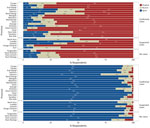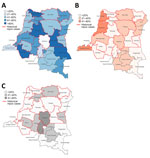Volume 30, Number 12—December 2024
Dispatch
Mpox Vaccine Acceptance, Democratic Republic of the Congo
Abstract
We report general acceptance (61.0%) of an mpox vaccine in the Democratic Republic of the Congo among 5,226 survey respondents. Healthcare workers and respondents in historic mpox-endemic regions had higher acceptance rates. These data highlight the need for increased community engagement and sensitization before widespread deployment of mpox vaccines.
Mpox, caused by monkeypox virus (MPXV), is a zoonotic infectious disease endemic to the Democratic Republic of the Congo (DRC) (1–3). In 2022, rapid worldwide spread of MPXV clade IIb resulted in >91,000 confirmed infections and prompted the World Health Organization to declare a public health emergency of international concern (4). In DRC, incident cases quadrupled from 2021 to 2023; during January 2023–July 2024, >28,000 suspected cases were reported, and new introductions were recorded in neighboring Burundi, Rwanda, Kenya, and Uganda (5). In August 2024, a travel-associated clade Ib case was reported in Sweden (6). In response to the expanding burden of mpox in 2024, the Africa Centres for Disease Control and Prevention declared a public health emergency of continental security (7) and the World Health Organization declared a public health emergency of international concern (4).
Despite deployment of a modified vaccinia Ankara-Bavarian Nordic vaccine (https://www.bavarian-nordic.com) to many high- and middle-income countries, access mpox vaccine is not currently available for the general population in Africa. One vaccination model suggests that vaccination of 80% of children <15 years of age in DRC would result in robust reductions in illness, death, and MPXV circulation (8). We conducted a survey to determine population attitudes towards and willingness to receive mpox vaccination in DRC.
For our cross-sectional analysis, we used data from a larger longitudinal telephone survey on COVID-19–related topics and vaccine hesitancy that began in 2022. The survey included participants from all 26 provinces in DRC and primarily targeted healthcare workers (HCWs). Participants were selected from historical telephone survey records of >10,000 persons. During December 2023–February 2024, trained interviewers contacted 5,226 adult participants and administered surveys in Swahili, French, Lingala, Kikongo, or Tshiluba. Survey questions addressed behavioral and social drivers of vaccination and attitudes toward introduction of new vaccines, including for mpox. Mpox vaccine acceptance was measured by asking participants about their interest in inclusion of an mpox vaccine in the national vaccination schedule. Response choices were yes, for adults, children, or both; no; and I do not know this disease (Appendix Table 1). We collapsed all yes responses for analysis. We assessed attitudes, vaccine acceptance by province, and sociodemographic characteristics via 5- or 3-level Likert scale questions and used a χ2 test for significance (α = 0.05).
Among respondents, 79.2% were male, 20.8% were female, and most (12.6%) were from Kwilu Province. Participant representation from urban or rural settings was roughly equivalent. Most (41.2%) respondents reported some college or university education, and 55.5% identified as HCWs (Table).
Participants generally disagreed with the statement that new vaccines carry more risks than older vaccines. However, in 4 provinces, Sud Kivu, Nord Ubangi, Nord Kivu, and Lualaba, >50% of respondents agreed with or felt that greater risks exist with newer vaccines. Respondents generally agreed with the statement that information received from the vaccination program was reliable and trustworthy. In Sankuru Province, 29.5% of respondents felt neutral about the reliability of vaccine program information; the highest percentage of vaccine information distrust and disagreement with the statement were in Haut Katanga (7.6%) and Lomami (6.8%) Provinces (Figure 1; Appendix Table 2).
Nationally, 61.0% (95% CI 59.6%–62.4%) of respondents expressed acceptance of an mpox vaccination, 21.7% had no interest, and 17.3% reported no knowledge of mpox. At the province level, >80% of respondents from Kwango, Tshuapa, Nord Ubangi, Tanganyika, and Maniema reported vaccine acceptance. Sankuru had the lowest acceptance rates (19.9%; 95% CI 14.3%–26.6%) and highest percentage (57.4%; 95% CI 49.7%–64.8%) of participants reporting no mpox knowledge. In general, rates of mpox vaccine acceptance and mpox disease knowledge were not influenced by the history of mpox cases within the province (Figure 2).
Interest in an mpox vaccine varied significantly by province (p<0.0001). When stratified by educational attainment, respondents with a high school diploma had much lower (49.8%; 95% CI 47.3%–52.3%) acceptance of the mpox vaccine than other groups. Among reported occupations, HCWs had the highest acceptance rates (69.4%; 95% CI 67.6%–71.1%). Respondents from rural locations indicated greater mpox vaccine acceptance than their urban counterparts (64.4% vs. 57.7%; p<0.0001). Among 4,396 respondents who reported receiving a COVID-19 vaccine, 63.2% indicated mpox vaccine acceptance. In addition, persons without chronic conditions reported higher rates of mpox vaccine acceptance than persons with chronic conditions (62.2% vs. 51.0%) (Figure 3).
Given the ongoing mpox clade Ia and clade Ib outbreaks in the DRC and identification of cases in adjacent countries in Central Africa, introduction of a vaccine is increasingly needed. However, a paucity of information has been available regarding mpox knowledge and vaccine acceptance across DRC. We observed greater interest in mpox vaccine deployment among respondents from rural than urban locations. That finding could be explained by the historic mpox burden in DRC, where mpox cases primarily were among children in rural regions. Currently, reported mpox cases are rising in urban centers, further challenging response and vaccine planning efforts.
Assessing mpox vaccine trust and acceptance across provinces that have and have not experienced mpox cases and across demographic variables did not yield clear or neatly described trends. Instead, we observed several outliers that may reflect the diversity of DRC. For example, differing vaccine acceptance rates between persons with and without chronic health conditions may indicate underlying health anxieties among persons with persistent health problems; further investigation is needed to clarify that relationship. In addition, Sankuru Province was consistently a vaccine-hesitant outlier in this survey. Sankuru had the lowest percentage of respondents who trust information received from national vaccine programs and the lowest mpox vaccine acceptance, primarily because 57.4% of respondents stated no knowledge of mpox. In DRC, most mpox-endemic provinces consist of rainforest or forest-savanna mosaic geographies; the southeast provinces are primarily savanna and grassland and have no history of reported mpox cases. However, in June 2024, Lualaba Province in the southeast reported its first mpox case. Of note, that province had the highest percentage of respondents believing that new vaccines have greater risks than older vaccines, although overall trust in national vaccine programs was high.
Although our results report an overall trend of vaccine trust and acceptance nationwide, they also indicate the need for a multifaceted approach to vaccine education and rollout. Strategies should be tailored to historically endemic regions and areas with lower vaccine acceptance, such as Sankuru or Kasai Central, and consider how personal experiences and cultural considerations intersect with mpox outbreaks. Of note, Haut Lomami Province has been the setting of long-standing routine immunization revitalization efforts (9,10), and 100% of respondents from that province reported that they feel information from the national vaccine program is reliable. That highly positive response is perhaps reflective of the many years of vaccine campaigns and education efforts in the region.
This survey was limited to persons with access to telephones; persons with a lower socioeconomic status, including those in largely rural regions, may have been inadvertently excluded. This study included respondents from all provinces in DRC and targeted HCWs. Past studies in DRC have demonstrated 54% acceptance toward outbreak-related vaccines, and HCWs continually express the highest acceptance among respondents (11). Because this study sought to enroll HCWs and community and religious leaders, we observed an overrepresentation of men because men primarily hold leadership roles in the country. Because HCWs and religious leaders serve as health recommenders for their communities, however, identifying and addressing vaccine acceptance among those groups is critical.
In conclusion, our findings provide insights regarding mpox vaccine acceptance within DRC. Our data highlight the need for increased community engagement and sensitization before widespread mpox vaccine deployment.
Ms. Petrichko is a master of public health student in the Department of Epidemiology at the Fielding School of Public Health, University of California, Los Angeles, Los Angeles, California, USA. Her research interests focus on infectious disease surveillance. Dr. Kindrachuk is an associate professor and Canada Research Chair at the University of Manitoba, Winnipeg, Manitoba, Canada. His research interests focus on the investigation of emerging and re-emerging viruses.
Acknowledgment
This article was preprinted at https://www.medrxiv.org/content/10.1101/2024.08.15.24311971v2.
References
- Bremen JG. Kalisa-Ruti, Steniowski MV, Zanotto E, Gromyko AI, Arita I. Human monkeypox, 1970–79. Bull World Health Organ. 1980;58:165–82.
- Foster SO, Brink EW, Hutchins DL, Pifer JM, Lourie B, Moser CR, et al. Human monkeypox. Bull World Health Organ. 1972;46:569–76.PubMedGoogle Scholar
- Ladnyj ID, Ziegler P, Kima E. A human infection caused by monkeypox virus in Basankusu Territory, Democratic Republic of the Congo. Bull World Health Organ. 1972;46:593–7.PubMedGoogle Scholar
- World Health Organization. Emergencies: mpox (monkeypox) outbreak [cited 2024 Aug 8]. https://www.who.int/europe/emergencies/situations/monkeypox
- World Health Organization, Regional Office for Africa. Mpox epidemic: Situation Report (SITREP) N°8 of 6 June 2024 [in French]. Kinshasa, DRC: Institut National de Sante Publique; 2024.
- European Center for Disease Prevention and Control. Mpox due to monkeypox virus clade I: epidemiological update. Geneva: The Center; 2024.
- Africa Centres for Disease Control and Prevention. Mpox outbreaks in Africa constitute a public health emergency of continental security [cited 2024 Aug 08]. https://africacdc.org/news-item/mpox-outbreaks-in-africa-constitute-a-public-health-emergency-of-continental-security
- Savinkina A, Kindrachuk J, Bogoch II, Rimoin AW, Hoff NA, Shaw SY, et al. Modelling vaccination approaches for mpox containment and mitigation in the Democratic Republic of the Congo. Lancet Glob Health. 2024;
S2214-109X(24)00384-X ; Epub ahead of print. DOIPubMedGoogle Scholar - Lame P, Milabyo A, Tangney S, Mbaka GO, Luhata C, Gargasson JL, et al. A successful national and multipartner approach to increase immunization coverage: the Democratic Republic of Congo Mashako Plan 2018–2020. Glob Health Sci Pract. 2023;11:
e2200326 . DOIPubMedGoogle Scholar - Banza Mpiongo P, Kibanza J, Kambol Yav F, Nyombo D, Mwepu L, Basame D, et al. Strengthening immunization programs through innovative sub-national public-private partnerships in selected provinces in the Democratic Republic of the Congo. Vaccine. 2023;41:7598–607. DOIPubMedGoogle Scholar
- Peckeu-Abboud L, Mangoni P, Chammam K, Kwete P, Mutombo Lupola P, Vanlerberghe V, et al. Drivers of routine and outbreak vaccination uptake in the western Democratic Republic of Congo: an exploratory study in ten health zones. Vaccines (Basel). 2022;10:1066. DOIPubMedGoogle Scholar
Figures
Table
Cite This ArticleOriginal Publication Date: October 23, 2024
1These first authors contributed equally to this article.
2These last authors contributed equally to this article.
Table of Contents – Volume 30, Number 12—December 2024
| EID Search Options |
|---|
|
|
|
|
|
|



Please use the form below to submit correspondence to the authors or contact them at the following address:
Anne W. Rimoin, Department of Epidemiology, Gordon-Levin Endowed Chair in Infectious Diseases and Public Health, Jonathan and Karin Fielding School of Public Health, University of California, Los Angeles, 650 Charles E. Young Dr, CHS 41-275, Los Angeles, CA 90095, USA
Top